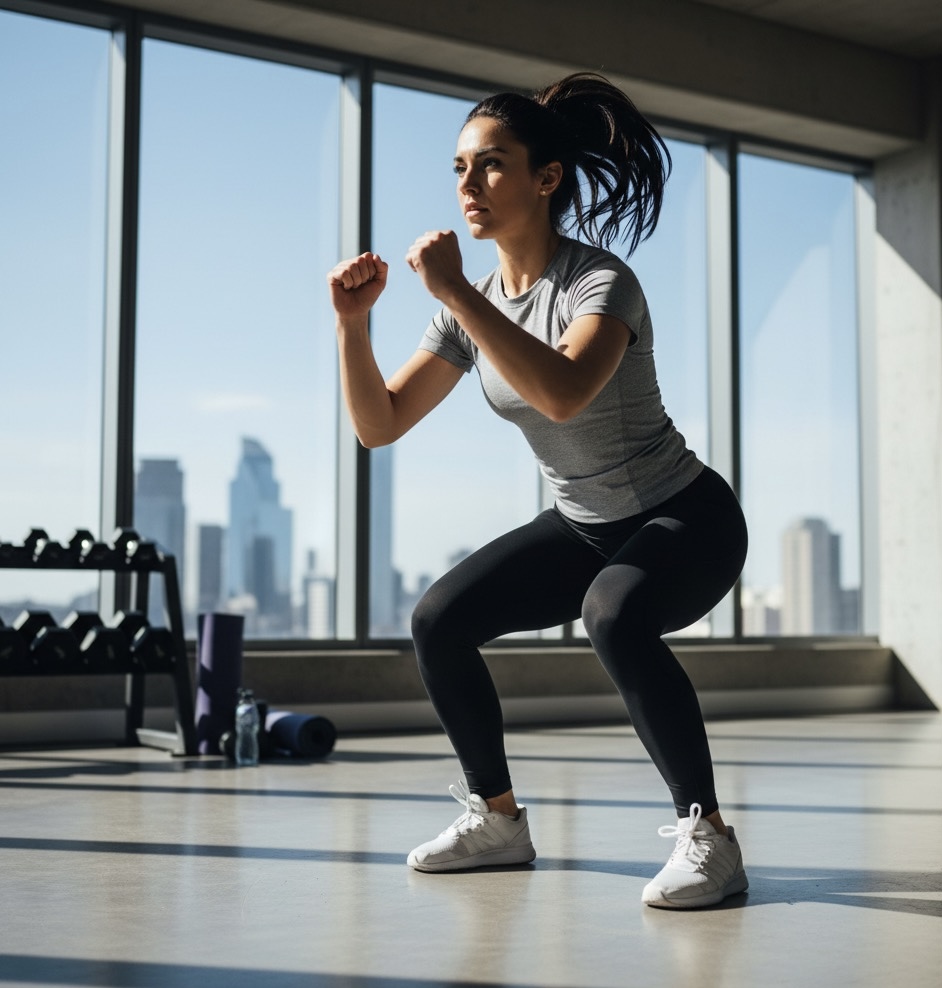
15-Minute Home Workout for Beginners (No Equipment Needed)
Simple Exercises to Build Strength, Burn Fat & Boost Energy
This simple routine helps you burn calories, tone your body, and improve fitness right at home. Perfect for weight loss and daily exercise.
Introduction
Starting your fitness journey can feel overwhelming. Many people think they need expensive gym memberships, fancy equipment, or complicated routines to make progress. The truth is, you can improve your fitness right where you are, using only your bodyweight.
A 15-minute home workout is short enough to fit into your busy day, simple enough for beginners, and effective enough to build strength, burn calories, and boost your energy levels. You can do it in your living room, kitchen, bedroom, or even outside, no excuses, no equipment required!
In this guide, we’ll walk you through a beginner-friendly workout you can start today, along with tips on how to stay motivated and avoid common mistakes.
Why a 15-Minute Workout Is Effective
You might wonder how a short workout can actually be effective. Here’s why a 15-minute routine can be beneficial:
1. Easy to Start
Short workouts feel less intimidating. When you know you only need to commit to 15 minutes, you’re more likely to stick with it. This is especially important for beginners who may feel daunted by longer sessions.
2. Burns Fat and Tones Muscles
Bodyweight exercises engage multiple muscle groups at once. This not only helps you build strength but also boosts your calorie burn, making it easier to lose weight or maintain a healthy weight.
3. Improves Heart and Lung Health
Consistent movement increases your heart rate, which is great for your cardiovascular health. A stronger heart and lungs mean better endurance and overall well-being.
4. Cost-Free
You don’t need any equipment, gym fees, or fancy workout clothes, just your commitment and willingness to move. This makes it accessible to everyone, regardless of budget.
5. Suitable for All Ages
The exercises in this routine are low-impact and can be modified based on your ability. Whether you’re young or older, fit or just starting out, this workout can work for you.
Warm-Up (2 Minutes)
Before diving into the main workout, it’s essential to warm up your body. A proper warm-up prepares your muscles and joints for exercise, reducing the risk of injury.
Warm-Up Routine:
1. March in Place:
Stand tall and march in place, lifting your knees high. Swing your arms naturally. Do this for about 30 seconds.
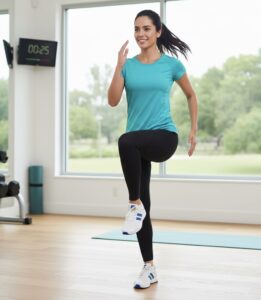
2. Arm Circles:
Extend your arms out to the sides and make slow, controlled circles. Start with small circles and gradually increase the size. Do this for about 30 seconds, then reverse the direction.
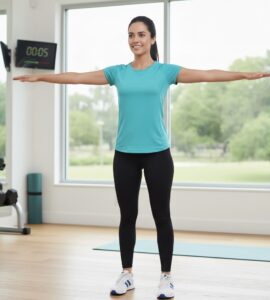
3. Side Steps with Squats:
Step side to side while adding a gentle squat. When you step to the right, squat down slightly, then return to standing and repeat on the left side. Continue for about 30 seconds.

4. Deep Breaths:
Take slow, deep breaths to relax your shoulders and get comfortable with moving. Inhale through your nose and exhale through your mouth. Do this for about 30 seconds.
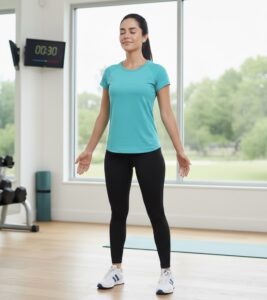
Keep your movements light and easy. The goal is to get your blood flowing and your body ready for exercise.
The 15-Minute Home Workout Routine
For each exercise, aim to work for about 45 seconds, then rest for 15 seconds before moving to the next one. Go at your own pace and listen to your body. If you need to take longer breaks, that’s perfectly fine!
1. Bodyweight Squats
Strengthens your legs, glutes, and core.

How to Do It:
Stand with your feet hip-width apart. Bend your knees and push your hips back, as if you’re sitting in a chair. Keep your chest lifted and your back straight. Stand back up and repeat. If it’s difficult, go as low as feels comfortable.
Benefits:
Squats are excellent for building lower body strength. They target your quadriceps, hamstrings, glutes, and even your core. Plus, they help improve your balance and stability.
2. Standing March or Light Jog in Place
Gently raises your heart rate and warms your muscles.
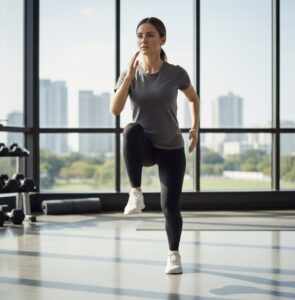
Lift one knee at a time while swinging your arms naturally. Move steadily and breathe regularly. If you feel comfortable, you can transition into a light jog in place.
Benefits:
This exercise gets your heart pumping and prepares your body for more intense movements. It also engages your core and helps improve coordination.
3. Wall Push-Ups
Strengthens your chest, arms, and shoulders without strain.
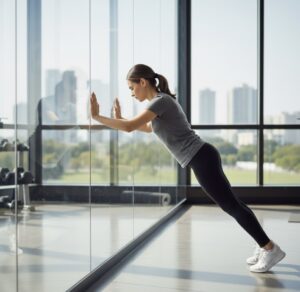
Stand facing a wall with your feet about two feet away. Place your hands on the wall at chest height. Lean your body toward the wall, then push back to standing.
Benefits:
Wall push-ups are a great way to build upper body strength without the strain of traditional push-ups. They target your chest, shoulders, and triceps while being gentle on your joints.
4. Glute Bridge
Strengthens glutes, hamstrings, and improves lower-back support.

Lie on your back with your knees bent and feet flat on the floor, hip-width apart. Lift your hips upward while squeezing your glute muscles. Lower back down slowly and repeat.
Benefits:
The glute bridge is fantastic for strengthening your posterior chain, which includes your glutes, hamstrings, and lower back. This exercise helps improve posture and stability.
5. Standing Side Leg Raises
Supports balance, hip strength, and core stability.
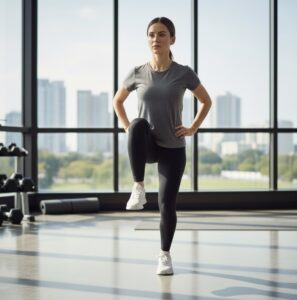
Stand tall and lift one leg out to the side while keeping your upper body steady. Lower the leg slowly and repeat. Switch to the other leg halfway through.
Benefits:
Side leg raises strengthen your hip abductors, which are important for maintaining balance and stability. They also engage your core muscles as you work to keep your upper body still.
6. Standing Knee-to-Elbow Crunch
Strengthens your abdominal muscles without lying on the floor.

Stand tall and lift one knee while bringing the opposite elbow toward it. Switch sides and continue alternating in a smooth rhythm. Engage your core by pulling your belly inward during the movement.
Benefits:
This exercise targets your obliques and rectus abdominis, helping to build core strength. It also improves coordination and balance as you move.
Cool Down & Stretch (3 Minutes)
After your workout, it’s important to cool down and stretch to help your muscles recover and improve flexibility.
Cool Down Routine:
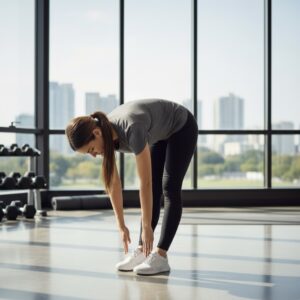
1. Standing Forward Bend:
Stand tall and slowly bend forward at the hips, letting your arms hang toward the floor. Hold this position for about 20-30 seconds, breathing deeply.
2. Seated Hamstring Stretch:
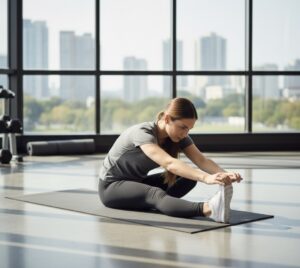
Sit on the floor with one leg extended and the other leg bent. Reach toward your toes on the extended leg, feeling the stretch in your hamstring. Hold for 20-30 seconds, then switch legs.
3. Shoulder Stretch:
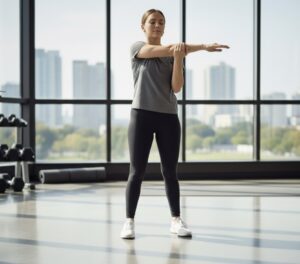
Bring one arm across your body and gently pull it closer with the opposite arm. Hold for 20-30 seconds, then switch sides.
4. Deep Breaths: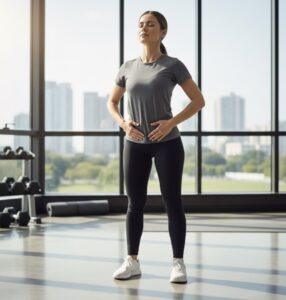
Finish with a few deep breaths. Inhale through your nose, filling your lungs, and exhale through your mouth. Do this for about 30 seconds to help your heart rate return to normal.
How Often to Do This Workout
Aim to do this routine 4 to 5 times per week. As the exercises become easier and you feel more comfortable, you can:
– Increase the duration to 20 minutes.
– Repeat the circuit twice for a more challenging workout.
– Move a little faster (but always with control) to increase intensity.
Remember, consistency is key! It’s better to do shorter workouts regularly than to push too hard and risk burnout or injury.
Common Beginner Mistakes to Avoid
As you start your fitness journey, here are some common mistakes to watch out for:
1. Holding Your Breath:
Always breathe steadily throughout your workout. Proper breathing helps maintain your energy and keeps your muscles engaged.
2. Rushing the Movements:
Focus on control rather than speed. Slow, controlled movements are more effective for building strength and reducing the risk of injury.
3. Comparing Yourself to Others:
Everyone’s fitness journey is unique. Focus on your own progress and celebrate your achievements, no matter how small.
4. Doing Too Much Too Soon:
Give your body time to adapt to new exercises. Gradually increase the intensity and duration of your workouts to avoid injury.
Progress takes time, but it does happen! Celebrate every step you take toward better health.
How to Stay Motivated
Staying motivated can be challenging, especially when you’re just starting out. Here are some tips to help keep your spirits high:
1. Play Music You Enjoy:
Create a workout playlist with songs that energize you. Music can make your workout feel more enjoyable and help you push through tough moments.
2. Schedule Your Workouts:
Treat your workout like an important appointment. Set aside the same time each day to make it a part of your routine.
3. Celebrate Small Wins:
Acknowledge your achievements, whether it’s completing three workouts in a week or increasing your workout duration. Celebrating small victories can boost your confidence.
4. Keep a Journal:
Write down how you feel after each workout. Noticing the energy boost and mood improvement can motivate you to keep going.
5. Find a Workout Buddy:
Exercising with a friend can make workouts more fun and hold you accountable. You can encourage each other and share your progress.
Remember, progress is built through consistency, not perfection. Every little effort counts!
Frequently Asked Questions
Can this workout help with weight loss?
Yes! This workout can be effective for weight loss, especially when combined with a balanced diet and consistent effort. Burning calories through exercise, along with healthy eating, creates a calorie deficit, which is essential for weight loss.
What if I am overweight or out of shape?
This workout is designed to be beginner-friendly. Listen to your body and move at your own pace. It’s perfectly okay to take breaks or modify exercises to suit your comfort level.
How long before I see results?
You may notice increased energy within just a few days of consistent exercise. Visible physical changes often appear within 3 to 6 weeks, depending on your starting point and commitment.
Conclusion
You don’t need a gym to improve your fitness. You don’t need expensive equipment or long, complicated routines. All you need is your body, your space, and just 15 minutes.
Start where you are.
Use what you have.
Take it one workout at a time.
Your journey to becoming your strongest, healthiest self begins today! Embrace the process, stay consistent, and enjoy the benefits of a healthier lifestyle.



